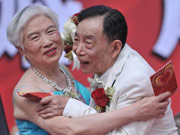VI. Rights of Ethnic Minorities
China has established the principle that all ethnic groups are equal and jointly participate in the management of state affairs on the constitutional, legal and systemic levels. The state respects the cultural differences and lifestyles of ethnic groups, and ensures the equal rights of ethnic minorities in politics, economy, culture, language and folk customs, religious belief and other aspects, with coordinated measures. In 2013 China's ethnic minorities and areas inhibited by ethnic minorities made new achievements and developments in various undertakings, and all ethnic minorities fully enjoyed and effectively exercised their basic rights.
The political rights of ethnic minorities are fully guaranteed. Areas inhibited by ethnic minorities in compact communities exercising regional ethnic autonomy enjoy autonomous rights in a wide range of areas, including legislative power, flexibility in the execution of relevant state laws and regulations, the right to use their own spoken and written languages, personnel management power, financial management power, and the right of independently developing their special culture and education. The advantages of regional ethnic autonomy are best exemplified in the Xinjiang Uygur Autonomous Region. Xinjiang is an ethnic autonomous area mainly inhibited by the Uygur people. It is China's only autonomous region with all three administrative levels of autonomous areas (region, prefecture and county). In other parts of Xinjiang inhabited by ethnic minorities, except the Uygur, in compact communities, there are five autonomous prefectures where the Kazak, Hui, Kirgiz and Mongolian people are concentrated; six autonomous counties where the Kazak, Hui, Mongolian, Tajik and Xibe people live; and 42 townships where various ethnic minorities live. Autonomous organs at all levels in Xinjiang formulate and implement autonomous regulations, local rules and regulations, and legally binding decisions in light of their actual conditions, ensuring the autonomous rights of ethnic autonomous areas.
All China's 55 ethnic minority groups elect deputies to the NPC and members to the National Committee of the CPPCC. The chairpersons or vice chairpersons of the standing committees of the people's congresses of all 155 areas where regional ethnic autonomy is exercised, as well as the heads of government of autonomous regions, prefectures, counties or banners are citizens of the ethnic group or groups exercising regional autonomy in the areas concerned. In the Tibet Autonomous Region the chairpersons of past standing committees of the people's congress and the heads of the people's government have all been Tibetans. Tibetan deputies and deputies from other minority groups to the NPC have always constituted the absolute majority among deputies of the region at all levels. In Tibet, of the 34,244 directly and indirectly elected deputies to the NPC at all four levels, 31,901 persons, or 93 percent, are from the Tibetan or other minority communities. Also, 82.05 percent of the total number of the Tibet Autonomous Region's officials are Tibetan or from other minority groups, and 80.06 percent of the total number of leading officials of counties and townships are Tibetan or from other minority groups.
The socioeconomic rights of ethnic minorities are fully protected. The state continues to increase funds in promoting socioeconomic development in areas inhibited by ethnic minorities, and significant achievements have been made in this regard. In 2013, with more transfer payments diverted to ethnic minority areas, the central government arranged 46.4 billion yuan of transfer payments to ethnic minority areas, up by 10.5 percent as compared with 2012. The state increased poverty-reduction funding by a large margin for the Inner Mongolia, Guangxi, Tibet, Ningxia and Xinjiang autonomous regions, and Guizhou, Yunnan and Qinghai provinces, which have large numbers of ethnic minority inhabitants. The central government appropriated 16.605 billion yuan as poverty-reduction fund, or 43.76 percent of the total volume from all sources, growing by 16.8 percent compared to 2012. In 2013 the state took concrete measures to implement three special programs, as stated in the Twelfth Five-year Plan, namely, supporting the development of minority groups with small populations, vitalizing border areas and bring prosperity to their residents, and developing special undertakings for ethnic minorities. The state continued to increase support to ethnic minorities and areas inhabited by minorities, providing 1.45 billion yuan as specialized funds for the development of minority groups with small populations, 2.79 billion yuan as specialized funds for vitalizing border areas and bringing prosperity to their residents, and 400 million yuan as specialized funds for protecting ethnic minority villages with cultural significance. These funds increased by 13.1 percent, 50 percent and 53.8 percent, respectively, as compared to 2012. In 2013 the GDP of the Tibet Autonomous Region reached 80.767 billion yuan, growing by 12.5 percent over the previous year; the per capita net income of farmers and herdsmen was 6,578 yuan, increasing by 15 percent over the previous year and well into the 11th year of double-digit growth; and the per capita disposable income of urban residents reached 20,023 yuan, up by 11.1 percent compared with 2012. In 2013 the GDP of Xinjiang Uygur Autonomous Region was 851 billion yuan, growing by 11.1 percent compared to the previous year; and the per capita GDP was 37,847 yuan, an increase of 9.7 percent. In 2013 the per capita net income of rural residents in Xinjiang reached 7,296 yuan, growing by 14.1 percent over the previous year; and the per capita disposable income of urban residents was 19,874 yuan, increasing by 10.9 percent over the previous year. The per capita total income of urban households was 22,388 yuan, up by 10.9 percent compared to the previous year and was 69.5 times more than that of 1978. In 2013 the per capita living space of Tibetan farmers and herdsmen and urban residents was 30.51 sq m and 42.81 sq m, respectively, and significant progress was made in various undertakings for improving the local people' s lives. The housing project for farmers and herdsmen, in particular, was completed after eight years of incremental investment that totaled 27.357 billion yuan. The region's 2.3 million farmers and herdsmen of 460,300 households moved into solid and convenient houses, and a historic improvement was made in the working and living conditions of farmers and herdsmen. More progress was made in the building of supporting facilities in rural areas, including water, power, road, communications, gas, radio and television, and postal services. A total of 94.6 percent and 99.7 percent of Tibet's townships and towns respectively now have access to postal services and the road network, respectively, and 97.4 percent of incorporated villages have access to road transportation. The Motuo Highway opened to traffic in 2013, connecting China's last isolated county to the national road network. Construction of the Sichuan-Tibet highway network project began. The Qinghai-Tibet Railway transported a total of 2.199 million passengers and 4.052 million tons of cargo, and civil aircraft carried 2.73 million passengers. (more)
Ethnic minority cultures and cultural undertakings in areas inhabited by ethnic minorities prospered. By 2013 China had 32 publishing houses that publish books in the languages of ethnic minorities, and 13 electronic publishers produce audio-visual products in languages of ethnic minorities. In 2013 222 titles of periodicals, 99 types of newspapers and 9,429 book titles were published in languages of ethnic minorities. In 2013 a total of 73 radio stations in ethnic autonomous areas ran 441 programs, including 100 programs broadcast in ethnic languages; and 90 television stations ran 489 programs, including 100 programs broadcast in ethnic languages. There were also 50,834 cultural institutions of various types, including 653 libraries, 784 cultural centers, 8,153 cultural stations and 385 museums. The traditional cultures of minority groups are protected. The state established an experimental area for the protection of the culture and ecology of ethnic minorities living in southeastern Guizhou Province, effectively promoting the overall conservation of the intangible cultural heritage in ethnic minority areas. The state continues to strengthen the protection and development of traditional medicine of ethnic minorities. The state supports experienced elderly experts of ethnic medicine to set up offices to pass on their medical inheritance, and supports the establishment of inheritance offices for different schools of Tibetan, Mongolian, Zhuang and Hui medicines. A program for the categorization of ethnic medicine literature and the selection and promotion of medical techniques has been initiated, covering 29 ethnic groups in 11 provinces and autonomous regions. A total of 150 titles of important ethnic medicine literature has been sorted out and categorized, and 140 medical treatment techniques have been selected for promotion. By 2013 there were 199 hospitals nationwide that specialize in ethnic medicine.
People of ethnic minority groups in Xinjiang enjoy freedom of religious belief, and their customs and social mores are fully respected. In accordance with the Constitution and the Law on Regional Ethnic Autonomy, the Xinjiang Uygur Autonomous Region promulgated the Regulations on the Administration of Religious Affairs of the Xinjiang Uygur Autonomous Region, Interim Regulations on the Administration of Venues for Religious Activities of the Xinjiang Uygur Autonomous Region, Interim Regulations on the Administration of Religious Staff of the Xinjiang Uygur Autonomous Region, Interim Regulations on the Administration of Religious Activities of the Xinjiang Uygur Autonomous Region, and other government regulations, in an effort to protect normal religious activities and safeguard the legitimate rights and interests of religious groups and religious believers. The religious believers from ethnic minority groups in Xinjiang are entitled to conducting normal religious activities according to law in venues for such activities and in their homes, rights with which no one may interfere. Currently there are ten minority groups in Xinjiang that mostly believe in Islam, with a total population of around 13.7 million. There are 24,000 mosques with 290,000 staff members. In Xinjiang there are also 120,000 Buddhist believers, with 53 venues for activities and 326 staff members; about 60,000 Protestant followers and 374 clergymen; 6,000 Catholic followers, with 20 venues for activities and 25 priests; 1,000 Orthodox believers with three venues and two priests; and 300 Daoist believers with one venue for activities. Xinjiang has published and distributed the Koran, Sahih al-Bukhari, Tafsir al-Mizan, Selected Texts of Expostulation (a1-Wa 'z) and other religious classics and books in the Uygur, standard Chinese, Kazak and Kirgiz languages. The central government and governments at all levels of Xinjiang have developed a series of policies and regulations to ensure that the customs of ethnic minorities in food and drinks, clothing, festivals, marriages and funerals are respected and given consideration. Each year governments at all levels in Xinjiang make special arrangements for the production and supply of meat, non-staple food and other necessities for the daily life of ethnic minorities ensuring the production and supply of special foods for these ethnic minorities, and lends special consideration to the ten groups dominated by Islamic believers. In Xinjiang, Moslems of all ethnic groups enjoy days off on the occasions of Eid-ul-Fitr and Eid al-Adha.
The cultural legacies of Tibet are effectively protected, and the local religion and traditional customs and social mores are respected. Currently Tibet has 4,277 sites of cultural relics. The Potala Palace, Norbulingka Summer Palace and Jokhang Temple have been included in the UNESCO World Heritage List; Lhasa, Shigatse and Gyantse have been entered on the national list of historical and cultural cities; and the Tibet Museum is a first-rank national museum. Seventy-six items on China's national intangible cultural heritage list are located in Tibet, 323 at the autonomous regional level, 76 at the city level and 814 at the county level. There are 68 recognized successors to their own intangible heritages in Tibet at the national level and 227 at the autonomous regional level, and 117 Tibetan Opera troupes. The epic Gesar and Tibetan Opera were included on the list of Masterpieces of Oral and Intangible Heritage of Humanity in 2009. The state actively protects and develops Tibetan medicine. Currently Tibet has 19 medical institutions that specialize in traditional Tibetan medicine, more than 50 county-level hospitals have a Tibetan medicine department, and the service network of Tibetan medicine has basically covered the whole region. The state respects the customs and social mores of the Tibetan people, and ensures that the ethnic communities of Tibet lead their lives in accordance with their traditional customs and engage in social activities in ways they prefer. The state respects the freedom of religious belief of all the people in Tibet, and ensures that they can practice their religions, conduct ceremonial activities, participate in major religious and folk festivals and engage in other normal activities of their own free will. Currently there are 1,787 venues for religious activities of various types in Tibet, with 46,000 resident monks and nuns, and 358 living Buddhas. Traditional religious activities, such as scripture study and debate, rank promotion, initiation, abhiseca (empowerment) and training, are conducted in an orderly manner, and traditional activities are held at major religious festivals. The living Buddha reincarnation system is a unique practice for the continuation of the living Buddha of Tibetan Buddhism, which is respected by the state. Since the Democratic Reform in Tibet in 1959, over 60 reincarnated living Buddhas have been certified and recognized by the state in accordance with historical conventions and following religious rituals. Many religious believers have sutra halls or small shrines set up in their homes, and they have the liberty to engage in religious activities such as turning prayer wheels, going on pilgrimages, and having monks and nuns perform religious rites. The Tibet Autonomous Region and all of its seven prefectures and cities have Buddhist associations, and the Tibet branch of the China Buddhist Association has a Buddhist academy and a sutra printing house, and publishes Tibetan Buddhism, a journal in the Tibetan language. Religious cultural items, such as murals, sculptures, statues, Thangka paintings, scriptures, ritual items and shrines in Buddhist temples, are protected and renovated when this is needed. Large quantities of religious literature and classics are rescued, sorted out and published. The traditional sutra printing houses of different temples are maintained and developed. Currently there are 60 major sutra printing houses, such as the ones at Muru Nyingba Monastery and the Potala Palace. They print a total of 63,000 titles of scriptures annually, and there are 20 private bookstalls selling scriptures in Tibet.
Ethnic minorities have the right to use and develop their own spoken and written languages. The state takes concrete measures to ensure the legitimate use of ethnic languages in the administrative and judicial sectors, news and publication, radio, film and television, culture and education, and other areas. Ethnic minority students can use their own languages in the college entrance examination. China National Radio and local radio stations broadcast in 21 ethnic languages on a daily basis, and the coverage of radio and television broadcasts in ethnic languages in border areas has further increased. The state promotes bilingual teaching in ethnic areas. By 2013 bilingual teaching was done in the classroom in more than 10,000 schools around the country, and 29 languages of 21 ethnic minority groups were used together with standard Chinese-Putonghua. China has 15 institutions of higher learning for ethnic minority students, with approximately 240,000 students on campus. The state continues the preferential policy toward ethnic minority students in college admissions by lowering the admission scores for or granting extra scores to them, and by granting priority admissions to these students when they are competing with Han students under the same conditions. Special consideration is also given to students from ethnic minority groups with small populations.
The learning and use of the Tibetan language is protected by law. Both the Tibetan language and standard Chinese are used in the decisions and regulations passed at the people's congresses at all levels in the Tibet Autonomous Region, as well as in the official documents and public notices issued by people's governments at all levels and their subordinate departments. In judicial litigation the Tibetan language is used during trials when there are Tibetan parties involved, and the legal instruments are written in Tibetan in such cases. Both Tibetan and standard Chinese appear in the official seals, credentials, forms, envelopes, letter paper, writing paper, insignias of different entities, and are used in the signs and plaques of government organs, factories and mines, schools, train stations, airports, stores, hotels, restaurants, theaters, tourism spots, stadiums and libraries, and on street nameplates and road signs. Tibet has 14 journals and ten newspapers published in the Tibetan language. The Tibet People's Radio Station runs 42 programs broadcast in Tibetan (including the Kangba dialect), broadcasting 21 hours of news programs in the Tibetan language and 18 hours of radio programs in the Kangba dialect on a daily basis. The Tibet Television Station Satellite Television broadcasts around the clock in Tibetan. In 2013 the Tibet Autonomous Region published 780 titles of books written in Tibetan, printing a total of 4.31 million copies. For many Tibetan-language users, reading, listening to and watching domestic and international news and getting other information through the Internet, mobile phones and other platforms compatible to the Tibetan language have become part of their daily life.
In Xinjiang, there are 13 ethnic groups who have lived there for generations, and they use ten different spoken and written languages. During the performance of official business, organs of the autonomous region and the autonomous prefectures and counties use both standard Chinese and the local ethnic languages. The languages of the ethnic minorities are also widely used in the press, publication, radio, film and television. The Xinjiang Daily is published in the Uygur, standard Chinese, Kazak and Mongolian languages; the Xinjiang Television Station broadcasts in the Uygur, standard Chinese, Kazak and Mongolian languages; and the Xinjiang People's Publishing House publishes in the Uygur, standard Chinese, Kazak, Mongolian, Kirgiz and Xibe languages. More than 70 percent of the books and audio-visual products published by publishing houses in Xinjiang are in local ethnic languages. In 2013 subtitles in ethnic languages were added to 100 films and 5,975 episodes of TV series, and four TV dramas were made with ethnic minority themes.
 |  |

 16 Chinese films with a Cannes Award
16 Chinese films with a Cannes Award Best photos of the week (May 5 - May 11)
Best photos of the week (May 5 - May 11) Opening ceremony of 67th Cannes Film Festival
Opening ceremony of 67th Cannes Film Festival Silent world of EOD personnel
Silent world of EOD personnel Who is China's campus beauty queen?
Who is China's campus beauty queen? School for juvenile offenders behind bars
School for juvenile offenders behind bars Dance competition in Guizhou attracts more than 3,000 enthusiasts
Dance competition in Guizhou attracts more than 3,000 enthusiasts Golden wedding celebration in Chongqing
Golden wedding celebration in Chongqing China's J-11 fighters in actual-combat training
China's J-11 fighters in actual-combat training Six years after Wenchuan earthquake
Six years after Wenchuan earthquake 
Day|Week|Month